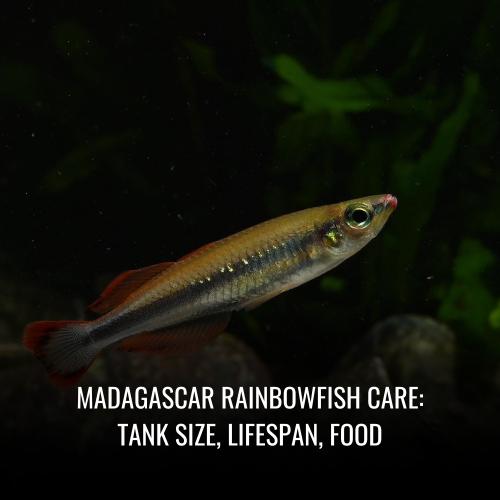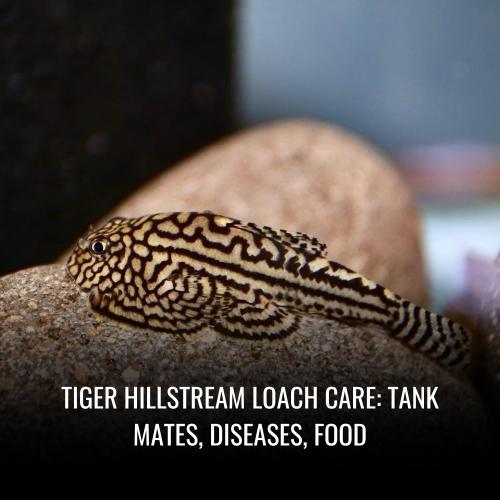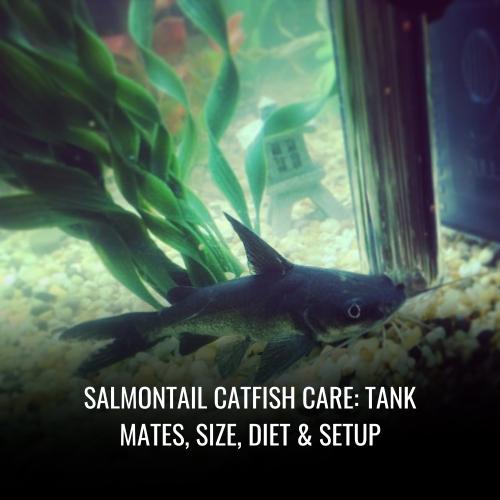The Black Ghost Knifefish (Apteronotus albifrons) is a captivating tropical fish native to the waters of South America. Its sleek, scale-less body and undulating movements make it a standout in any aquarium.
Here’s a handy table with essential care information:
| Attribute | Detail |
|---|---|
| Scientific Name | Apteronotus albifrons |
| Common Name | Black Ghost Knifefish |
| Family | Apteronotidae |
| Usual Size in Tanks | Up to 20 inches (50 cm) |
| Recommended pH Range | 6.5-7.5 |
| Recommended dGH | 5-19 |
| Recommended Temperature | 73-80°F (23-27°C) |
| Reproduction | Egg layer |
| Origin | South America |
| Temperament | Generally peaceful |
| Compatibility | Can be aggressive with smaller fish |
| Tank Placement | Bottom dweller |
| Lifespan | Up to 15 years |
| Tank Size Requirement | Minimum 150 gallons |
| Filtration System | Required; prefers gentle water movement |
| Sexual Dimorphism | Not easily determined |
| Substrate Cleaning | Not applicable |
Black Ghost Knifefish employ electrical signals to interact with their environment. Though peaceful to similar-sized tank mates, they can be predatory. This nocturnal fish prefers dimly lit tanks with plenty of hiding spaces. Achieving an impressive size, they require a large tank with optimal water chemistry. Due to their specialized care needs, including a diet of meaty foods, they are best suited for aquarists with experience.
Scientific Name
The Black Ghost Knifefish, with its scientific moniker Apteronotus albifrons, carries a name inspired by Greek terminology. The prefix apteron translates to ‘without fins,’ while noton denotes ‘back.’ This nomenclature reflects the fish’s distinct lack of dorsal and pelvic fins, a feature emblematic of this species.
Belonging to the family Apteronotidae, these electric knifefish are indigenous to the waterways of South America and are the most prominent members of their family seen in aquariums. Their popularity stems from both their intriguing appearance and their unique behavioral traits.
| Attributes | Details |
|---|---|
| Scientific Classification | Apteronotus albifrons |
| Family | Apteronotidae (Electric knifefishes) |
| Origin | South America |
| Electrical Signaling | Uses electric discharges for navigation and communication |
Their aptitude for electric communication place them among the remarkable electrosensory systems in the animal kingdom.
Average Size
The Black Ghost Knifefish, scientifically known as Apteronotus albifrons, is recognized for its impressive size. In captivity, it is not uncommon for these fish to reach 18 to 20 inches when fully grown. This notable length classifies them as a relatively large species among tropical fish. It is a common misbelief that these fish will adjust their growth to the confines of their tank. However, the reality is their size potential remains unchanged, and to flourish, they require spacious habitats.
A tank that is too cramped can induce stress, trigger aggressive behavior, and lead to health complications in these scale-less fishes. To ensure well-being and stability, particularly when housing additional Black Ghost Knifefish, the tank’s capacity should be enlarged significantly. Each extra fish necessitates an increase of 80 to 100 gallons to adequately accommodate their territorial nature and activity. Responsible fishkeeping starts with understanding and meeting the spatial needs of these awe-inspiring creatures.
Lifespan
The longevity of the Black Ghost Knifefish, or Apteronotus albifrons, is a testament to their resilience in a well-maintained environment. On average, in the sanctuary of a home aquarium, they can expect to thrive for around 10 years. Nevertheless, with exemplary care, this lifespan can be extended, and some individuals may even celebrate their 15th birthday.
Genetic factors can influence longevity, resulting in certain fish outliving others naturally. However, environmental factors play a more immediate role, where water quality, a nutritious diet of meaty foods, ample space, and diligent tank maintenance are central to robust health. These controllable elements are critical in elongating the lifespan of this nocturnal electric fish.
Owners can infuse their fish’s life with vitality by focusing on a few key aspects of care showcased below:
| Factor | Guidelines for Care |
|---|---|
| Water Quality | Maintain pristine conditions with regular partial water changes and appropriate water chemistry checks. |
| Diet | Provide a variety of meaty foods to ensure comprehensive nutrition. |
| Tank Size | Adequate tank size to prevent stress and provide ample swimming space. |
| Maintenance | Consistent cleaning and filter management are vital for a hospitable environment. |
By attentively nurturing these aspects, enthusiasts of this cool and predatory fish enrich the likelihood of their Black Ghost Knifefish living to its full potential.
Natural Habitat
The Black Ghost Knifefish (Apteronotus albifrons) is steeped in the mystery of its South American origins. Revered for its ethereal presence, it thrives in the shadowy creek beds and riverbanks of the Amazon River basin. Countries like Brazil, Peru, and Colombia can boast of hosting these electrifying residents in their aquatic tapestries.
These elusive creatures favor the quietude of slow-moving or tranquil waters, amid dense vegetation where secrecy is their sanctuary. It’s here, in the comfort of a soft, sandy substrate, that they craft their reclusive daytime retreats. The black ghost knifefish’s adeptness at burying itself renders it nearly invisible against the riverbed, a stealthy tactic for daytime seclusion.
At dusk, the dynamic shifts—you’ll find it gliding with a ghostly grace as nocturnal instincts awaken. It’s a fascinating dance of shadow and silence, punctuated by the flashes of electrical impulses they’re famed for. Aquarists mimicking these conditions often find their Apteronotus albifrons most vibrant as evening falls.
| Habitat Feature | Preference |
|---|---|
| Location | Amazon River Basin (South America) |
| Water Movement | Slow or still |
| Substrate | Soft, sandy |
| Vegetation | Dense, near banks |
| Activity Cycle | Nocturnal, active at night |
This knowledge shapes the care for these tropical fish, ensuring they find a semblance of their cherished Amazonian habitat in the heart of an aquarium.
Appearance
The Black Ghost Knifefish (Apteronotus albifrons) showcases a distinct and striking form which is unparalleled in the aquarium world. Their long, slender bodies are shaped much like that of a knife, from which their common name is derived.
The body profile is characterized by a thin vertical aspect and tapering width which culminates into a remarkably skinny tail—adorned with spaced out white bands that stand out against the darkness of their bodies.
Devoid of both dorsal and caudal fins, the fish relies on a unique fin arrangement for movement. A continuous, rippling anal fin, reminiscent of the undulating wings of a stingray, stretches almost the entire length of the underside, propelling the fish with stability and grace.
On the body’s surface, a subtle ridge runs along the back, adding to this creature’s unusual silhouette. Intriguingly, their predominantly black skin shifts subtly in shade along this back ridge, offering a captivating nuance to their appearance.
| Physical Feature | Description |
|---|---|
| Body Shape | Long, slender, and resembling a knife blade |
| Color | Predominantly black with occasional variations on ridge |
| Fins | Lacks dorsal and caudal fins; uses anal fin for movement |
| Tail Bands | White rings spaced out on a very skinny tail |
| Skin | Scaleless with an ethereal texture |
The elegance of their swimming, evoked through undulating locomotion, makes the Black Ghost Knifefish an entrancing display of living art in the aquarium. The absence of scales confers an almost mystical cloak upon their form, rendering them one of the most intriguing aquatic creatures to observe.
Behavior & Temperament
In the confines of the aquarium, Black Ghost Knifefish are known for their active disposition, often spotted gliding close to the substrate where they forage for food. These fish take solace in hideaways, requiring the provision of adequate spaces to retreat throughout the day. The establishment of a social order among individuals can lead to a period of sparring as they assert hierarchy, with a singular dominant fish emerging within a group setting.
The electric fields, a signature attribute of these tropical fish, serve multiple purposes. Apart from facilitating navigation, these electrical signals are crucial in communication among conspecifics, dominance establishment, and in the sophisticated task of electrolocation for prey detection.

Are BLACK GHOST KNIFEFISH Fin Nippers?
The behavior of fin nipping is not characteristic of Black Ghost Knifefish; they are known to be generally peaceful towards other species and favor a diet focused on meatier fares.
Their unique swimming method, coupled with their nocturnal and reclusive nature, minimizes their chances of interacting with other fish that would otherwise become targets of fin-nipping aggression.
Furthermore, the inherent shyness and lack of scales make the Black Ghost Knifefish less prone to initiate conflicts that involve this type of behavior.
Are BLACK GHOST KNIFEFISH Aggressive To Each Other & Other Fish?
The Black Ghost Knifefish is relatively peaceful in an adequately sized tank that accounts for their need for personal space and hiding spots. However, they can exhibit territorial tendencies toward others of their species, and may become aggressive towards tankmates perceived as food due to their predatory nature.
Ensuring that the tank is not overcrowded, and that smaller fish cannot fit into the knifefish’s mouth, is crucial to maintaining harmony. Similarly, aggressive or predatory tankmates should be avoided to prevent potential stress and conflict, as the knifefish’s scaleless physique makes them vulnerable.
Are BLACK GHOST KNIFEFISH Friendly To Each Other & Other Fish?
Although the Black Ghost Knifefish is nocturnal and can be shy, they are capable of showing sociable behavior within a spacious aquarium, particularly when introduced to tankmates at a young age.
Despite being equipped with an advanced electrical system for communication and navigation, they may develop territorial behaviors if they feel overcrowded or threatened. In a compatible community with ample space and hiding spots, these knifefish will cohabit peacefully, provided the tank is devoid of aggressive or predatory companions.
Are BLACK GHOST KNIFEFISH Scooling Fish?
As far as social structures go, Black Ghost Knifefish do not exhibit schooling behavior and are often found to be solitary or existing in pairs. Territory establishment can become an issue in communal setups, making significant tank real estate with numerous hideouts essential for maintaining peace. Schooling is not part of their natural behavior, and they are well-suited to a life of solace, or with a carefully selected aquatic ensemble.
Can You Have Just One BLACK GHOST KNIFEFISH In The Tank?
Black Ghost Knifefish flourish as solitary individuals within the domain of a home aquarium. Singularity in habitat removes risks associated with aggression or territoriality toward their species.
As they age, their propensity for territorial behavior can intensify—this coupled with their large adult size dictates a need for substantial space. For these reasons, it is often recommended to feature a singular knifefish as the centerpiece of an aqueous arrangement.
Do BLACK GHOST KNIFEFISH Need To Be In Groups?
Contrary to popular belief, Black Ghost Knifefish do not necessitate group living to thrive and are quite territorial. Groups may lead to heightened aggression and stress if not managed with an abundance of space and ample hiding locations.
While some aquarists have found success with group living, it is generally advised to keep these scaleless specters individually to avoid confrontations and promote well-being.
Food & Diet
The dietary habits of Black Ghost Knifefish are rooted in their carnivorous nature, requiring a menu rich in protein to satisfy their nutritional needs. They are less inclined to accept flake or pellet foods, making live or frozen options such as bloodworms, prawns, and brine shrimp more suitable and stimulating choices. Evening or nocturnal feedings align best with their active hours, reducing food waste and mimicking their natural predatory behavior.
It is essential to regulate their food intake, as overfeeding can prompt health issues and degrade water quality due to increased waste production. When feeding Black Ghost Knifefish, it is crucial to ensure portions are well balanced to support their overall health and prevent any aquarium ecosystem imbalances.
| Preferred Foods | Benefits |
|---|---|
| Bloodworms | High in protein, supports growth and development |
| Brine Shrimp | Provides essential nutrients, good for overall well-being |
| Prawns | Offers enrichment, suitable for larger specimens |
| Mosquito Larvae | Mimics natural diet, provides stimulation |
| Planaria | Effective for variety and controlling tank populations |
Do BLACK GHOST KNIFEFISH Eat Algae?
Contrary to what some may assume due to their bottom-dwelling habits, Black Ghost Knifefish do not seek out algae as a primary food source. Their carnivorous diet drives them towards meaty foods that are rich in protein, like worms and small crustaceans.
Rather than grazing on plant matter, these impressive fish display a preference for hunting live prey, thus algae are largely inconsequential in their dietary regimen.
Do BLACK GHOST KNIFEFISH Eat Shrimp?
The inclusion of shrimp in the diet of Black Ghost Knifefish is not only acceptable but also beneficial. As meaty foods are the cornerstone of their nutrition, these fish relish the opportunity to feast on the likes of brine shrimp and prawns.
Shrimp, teeming with nutrients, can help maintain their healthy weight and support bodily functions, forming a prime component of the Black Ghost Knifefish’s diet.
Do BLACK GHOST KNIFEFISH Eat Bloodworms?
Bloodworms play a pivotal role in the diet of Black Ghost Knifefish, serving as a rich source of protein that drives their growth and vitality. Favoured among other edibles, bloodworms can be provided either live or in frozen form to facilitate feeding.
These worms supply vital nutrients that are key to the knifefish’s wellbeing and can, at times, be offered as an interactive dining experience either just beneath the water surface or even by hand.
Do BLACK GHOST KNIFEFISH Eat Mosquito Larvae?
Indeed, Black Ghost Knifefish are known to consume mosquito larvae, finding these to fit nicely into their menu of live foods. Mosquito larvae, like bloodworms, are a natural choice that provides a suite of nutritional benefits, strengthening the health and energy of these nocturnal hunters.
Additionally, feeding Black Ghost Knifefish mosquito larvae can add an aspect of environmental enrichment to their routine, aiding in replicating their natural hunting patterns.
Do BLACK GHOST KNIFEFISH Eat Planaria?
Black Ghost Knifefish display their predatory prowess by including planaria in their diet. These flatworms commonly found within aquariums become a welcome supplement, providing variety and aiding in the management of planaria populations in the tank.
Devouring these organisms reflects the knifefish’s adaptable and opportunistic feeding nature, highlighting their ability to forage on a broad spectrum of meaty foods.
Do BLACK GHOST KNIFEFISH Eat Plants?
The Black Ghost Knifefish’s carnivorous dietary habits generally exclude plants as a significant part of their intake. While they may occasionally nip at plants, this behavior is not typical and does not reflect a need for plant matter in their diet.
The focus for black ghost knife fish feeding should remain on protein sources such as live, frozen, or specially formulated carnivorous fish pellets, ensuring their needs are well catered to without reliance on aquatic vegetation.
Sexing: Male vs Female
Sexing Black Ghost Knifefish presents a unique challenge, as they show no obvious external differences between the sexes. The task of distinguishing males from females often necessitates expert techniques such as venting. This method involves a careful, internal examination to observe the shape and size of the genital papilla. Experienced breeders note that males typically possess a more pointed and elongated papilla, whereas females feature a rounder, bulkier one.
During the spawning period, behaviors may offer clues to the sex of these fish. Males are known to display increased vigor and assertiveness in their actions compared to their female counterparts. Although some aquarists might report that females can grow marginally larger, this size disparity should not be relied upon as a conclusive indicator of sex.
| Characteristic | Male | Female |
|---|---|---|
| Genital Papilla | Pointed and elongated | Rounder and larger |
| Spawning Behavior | Vigorous and assertive | Less active |
| Size (Not Definitive) | Often slightly smaller | May be slightly larger |
By closely observing these subtleties in physical traits and breeding conduct, enthusiasts can make more informed attempts to distinguish between male and female Black Ghost Knifefish.
BLACK GHOST KNIFEFISH Tank Mates
Black Ghost Knifefish, known for their tranquil demeanor, are suitable companions for a variety of peaceful freshwater species. When considering tank mates, size matters—opt for fish that won’t easily fit into the Knifefish’s mouth.
Ideal comrades include fish such as Electric Blue Acara, Silver Dollar Fish, Oscar Fish, Cory Catfish, and Rope Fish. These companions maintain harmony in the habitat, thanks to their non-aggressive nature that resembles the Black Ghost’s own temperament.
In cases where aquarists prefer smaller species like Celestial Pearl Danios or Green Neon Tetras, introduce them only while the Knifefish is still juvenile. As the Black Ghost grows, it’s advisable to avoid such tiny tank mates to prevent unintended predation.
Housing more than one Black Ghost Knifefish demands a spacious tank—preferably limited to a pair—to keep aggression in check. Their poor eyesight can lead to accidental collisions during feeding times, which might incite conflict. Ensure that your Knifefish have plenty of room to roam and explore without constant interaction.
| Preferred Tank Mates | Caution with Small Fish | Multiple Knifefish Housing |
|---|---|---|
| Electric Blue Acara | Celestial Pearl Danios | Max of two per tank |
| Silver Dollar Fish | Green Neon Tetras | Sufficient space required |
| Oscar Fish | Be mindful of potential aggression | |
| Cory Catfish | ||
| Rope Fish |
Remember, every aquatic community varies, and the tranquility of your tank hinges on providing ample space and compatible tank mates for your Black Ghost Knifefish.
Aquarium Setup
Creating a comfortable and suitable environment for Black Ghost Knifefish (Apteronotus albifrons) is crucial for their well-being. Originating from the Amazon Basin in South America, where they live among dense vegetation and complex structures, these scaleless and nocturnal fish require a carefully curated habitat. Your aquarium should replicate their natural surroundings, featuring clear PVC pipes for exploration, rock caves, pleco caves, driftwood, and an abundance of aquatic plants to mimic riverbeds in South America. The substrate should be soft—fine sand or gravel—to prevent damage to the knifefish’s delicate, scale-less skin.
As the Black Ghost Knifefish can reach an impressive size of up to 20 inches, they need ample space not only to feel secure but also to explore and exercise. Upgrading their environment as they grow is necessary, adjusting the size of caves and tunnels to offer them continuous shelter and safety. Indeed, these are cool fish that require a thoughtfully sized tank and decor.
Let’s delve deeper into ensuring the optimal conditions for these electrical fish, from the ideal tank size to the specifics of water chemistry and more.
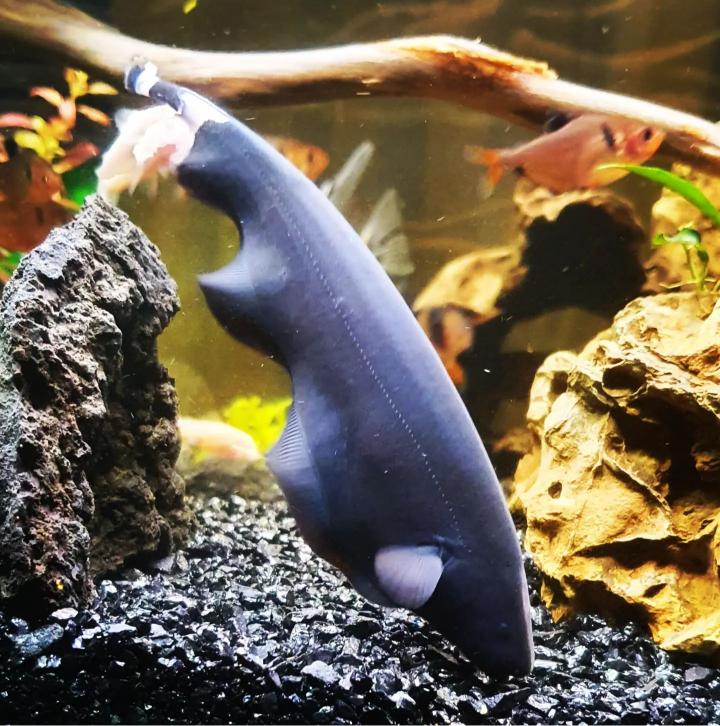
Ideal Tank Size
For a single adult Black Ghost Knifefish, the minimum tank size recommended is 100 gallons, considering their maximum size and need for swimming space. However, for those looking to add extra fish or provide a genuinely grandiose living space, a 120- or 180-gallon aquarium is ideal. This larger space allows these aquatic specters to gracefully glide through the water while minimizing any territorial tendencies that can appear, especially if considering housing more than one. Each additional knifefish would require an extra 80-100 gallons to prevent aggressive behavior that could emerge in an undersized tank.
Ideal Water Parameters
Black Ghost Knifefish thrive in water that closely mirrors the parameters of their native tropical rivers in South America. Water temperature is vital, with a comfortable range being 73°-82°F (23°-28°C). Achieving the right acidity and hardness is also key; therefore, maintain a pH level in the 6.0 to 7.5 range and a carbonate hardness (KH) between 5-10 dKH. These optimal conditions simulate the electrical fish’s natural habitat, promoting health and diminishing stress. Ensuring these parameters are stable is vital, as fluctuations can lead to stress and potential health problems in these electrical signal-sensitive fish.
Filtration
For Black Ghost Knifefish, efficient filtration goes a long way in guaranteeing a clean and healthy aquarium – they are known for their messy eating habits and subsequent high waste production. A potent canister filter or high-capacity power filter is recommended, as it should handle mechanical, chemical, and biological filtration effectively. While strong water flow is necessary to simulate their river habitat, too vigorous a current can be distressing, so aim for a balanced, gentle flow. Regular maintenance of the filtration system is also mandatory, with routine checks and cleansing of filter media ensuring the tank’s water quality remains high and conducive to the health of your Black Ghost Knifefish.
Lighting
To embrace the nocturnal nature of the Black Ghost Knifefish, dim lighting in the aquarium is preferred so as to not strain their eyes and emulate the light penetration of their native, densely vegetated habitat. Strategic placement of hiding spots and plants can offer the subdued lighting conditions they favor, while specialized lighting like blue moonlight or LED setups can simulate soothing moonlight environments during darker hours. Intense or bright lights should be avoided to prevent stress. Proper lighting techniques are not just aesthetic considerations – they contribute significantly to the natural behavior and psychological well-being of your Black Ghost Knifefish.
Common Possible Diseases & Prevention
Black Ghost Knifefish, without the armor of scales, are vulnerable to skin infections and parasites. A notorious ailment is Ich, signaled by white spots and unusual behavior. Also, injuries like cuts raise infection risks, demanding vigilance for any unusual signs.

Daily Health Check:
- Observe skin: Look for lesions or discoloration.
- Notice behavior: Signs of distress could be an early warning.
- Check activity levels: A lethargic fish might indicate health issues.
Disease Prevention:
- Quality Filtration: Install a top-tier filter, like the Fluval FX4, for optimal water quality.
- UV Sterilization: A UV sterilizer can reduce pathogens in the water.
- Routine Monitoring: Regular inspection can catch issues early, allowing for prompt treatment.
By being proactive and setting up a robust filtration system, these aquatic wonders can lead a healthier life. Keep a close eye on your Black Ghost Knifefish to enjoy their ghostly dances for years to come.
Breeding BLACK GHOST KNIFEFISH In Aquarium
Breeding Black Ghost Knifefish in an aquarium can be an intricate process, challenging yet rewarding for enthusiasts. The lack of sexual dimorphism in these fish means that males and females cannot be easily told apart until spawning. When ready to initiate breeding, the water temperature should be kept at 80-82°F (26-28°C), which mimics their warm South American habitat and encourages mating behavior.
For the best chance of success, a separate breeding tank is paramount, allowing for a serene environment away from the hustle of tank mates. Watch for the remarkable courtship display, where males and females perform synchronized swimming and the male circles the female during egg and sperm release.
Be prepared to protect the female’s precious offspring — potentially hundreds of eggs. Vigilant monitoring in the breeding tank is essential to ensure these eggs are safe from predators. With patience and care, the cycle of life for these ethereal creatures can be a satisfying addition to the hobbyist’s experience.
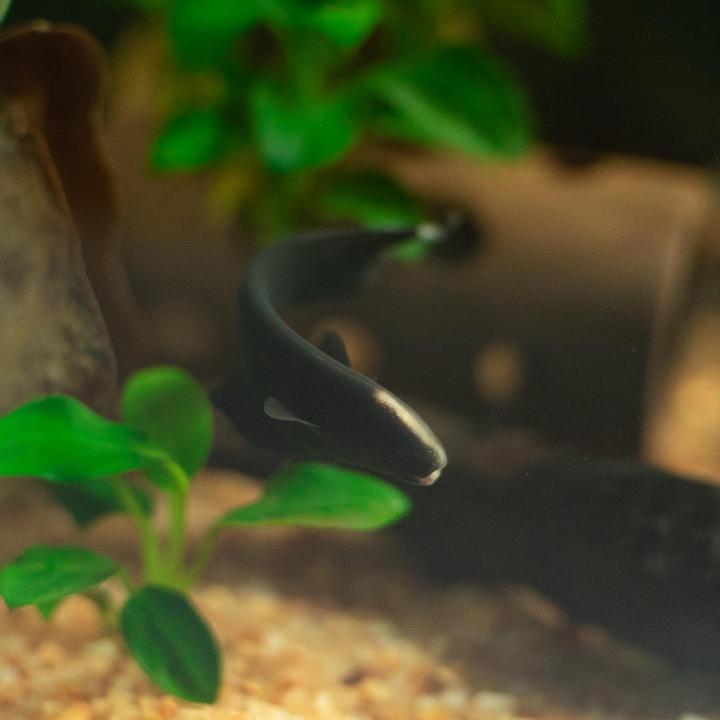
Breeding Tank Conditions:
- Water Temperature: 80-82°F (26-28°C)
- Tank: Separate breeding environment
Breeding Behavior:
- Courtship: Synchronized swimming displays
- Spawning: Male wraps around female to fertilize eggs
With the right conditions and careful attention, the breeding of Black Ghost Knifefish can be an enriching endeavor for tropical fish hobbyists.
Are BLACK GHOST KNIFEFISH Easy To Keep?
Black Ghost Knifefish, scientifically known as Apteronotus albifrons, stand out as one of the more unique and mystical species in the tropical fish community. However, their distinctive appearance and peculiar behaviors make them not the easiest fish to care for, especially for those just starting with aquarium keeping. Suggested primarily for seasoned aquarists, Black Ghost Knifefish demand attentive care due to their scaleless bodies, which are sensitive to diseases, and their need for substantial space.
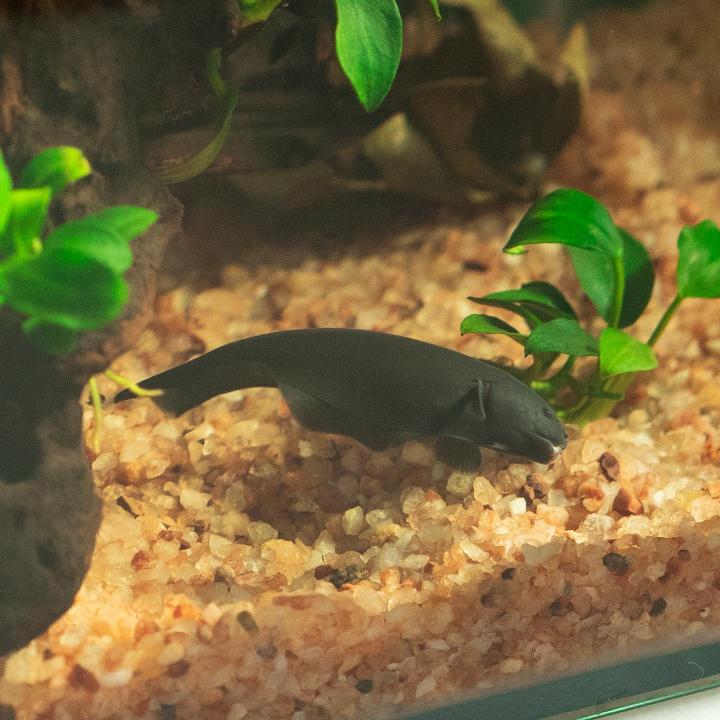
Are BLACK GHOST KNIFEFISH Sensitive To Water Changes?
Yes, Black Ghost Knifefish, also known as Apteronotus albifrons, are sensitive to water changes. As nocturnal and scale-less creatures, they require specific water conditions to thrive. It’s crucial to maintain optimal water chemistry, including slight acidity and temperatures between 73-80°F. Additionally, they are highly sensitive to poor water conditions, making partial water changes essential to mimic the clean, oxygen-rich streams of their natural habitat. These considerations are crucial for maintaining the health and well-being of Black Ghost Knifefish in a home aquarium.
Are BLACK GHOST KNIFEFISH Sensitive To Ammonia?
Yes, Black Ghost Knifefish are sensitive to ammonia. They require pristine water conditions to thrive in captivity. Ammonia is toxic to fish and can cause stress, illness, and even death if not properly managed. Regular water testing and maintenance are essential to prevent the buildup of ammonia in the aquarium. It’s important for aquarium enthusiasts to monitor and control the levels of ammonia to ensure the health and well-being of Black Ghost Knifefish in their environment.
Are BLACK GHOST KNIFEFISH Sensitive To Copper?
Yes, Black Ghost Knifefish are sensitive to copper. Copper is toxic to most fish species, including the Black Ghost Knifefish, and can have detrimental effects on their health and well-being. Aquarium enthusiasts need to avoid using copper-based medications or treatments in tanks housing these unique creatures. Careful consideration and monitoring of water quality, including the absence of copper, is crucial for creating a safe and suitable environment for Black Ghost Knifefish in captivity.

